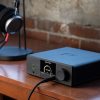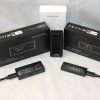With so much competition in the Dongle DAC category, it has become increasingly difficult to point to one specific model and place it upon the Iron Throne. Until now. We’ve covered Cayin’s DAPs and Dongle DACs over the past few years and it has become clear that Astell&Kern, FiiO, and Cayin are definitely ahead of the curve. Products like the new Cayin RU7 Dongle DAC are advancing the art of sound reproduction in the personal category and that is great news for headphone users.
Cayin was originally founded in 1993 to build tube amplifiers for the home market and quickly began innovating and expanding their product lineup. In 2013, Cayin expanded into portable audio and immediately made an impact with the N3 which offered a lot of features at a much lower price and that shook up the market.
Cayin moved into the high-end DAP space with the N6 and N8 models and later the N6ii and N8ii. All of those models did well but the DAP market is still small and interest in high-end DAPs is still limited to the Head-Fi universe.
One thing that isn’t small is the smartphone category with a few billion in circulation across the globe.
Cayin were certainly not the first to notice that headphone enthusiasts were using their smartphone and a Dongle DAC rather than a much more expensive DAP, but they had existing products in their lineup that could be used as the basis for a strong lineup of Dongle DACs and that started with the R01 DAC/Headphone Amplifier module from the N6ii DAP — which was reworked into the RU6 Dongle DAC.
The launch of that product gave listeners the option to buy into the Cayin ecosystem without having to spend $1,500 for an N6ii and modules or the flagship N8ii DAP.
Priced at $249 USD when it launched the Cayin RU6 was a massive bargain.

Looking Back…
We reviewed the Cayin RU6 almost twelve months ago and felt that it offered rather high-end performance with the caveat that it drew more power than some Apple devices could handle and that it became rather hot during extended listening sessions.
Putting aside those two issues, the RU6 has been an extremely strong seller for Cayin.
More recently, Cayin sent us the N7 DAP which proved to be a huge departure from the N8ii, or the N6ii/RU6 offerings; the latest model utilizes a single bit DSD DAC instead of the ladder DAC of the R01 module and RU6 or the Delta/Sigma DACs of the other N8ii and N6ii modules.
As much as I enjoyed my time listening to the N7 and its more organic sounding tonal balance compared to the analytical sounding R-2R Ladder DAC in the RU6 — the $1,600 USD asking price was a huge deterrent.
Knowing that market was hungry for a truly state-of-the-art Dongle DAC, Cayin has introduced the RU7 which is meant to replicate what the RU6 accomplished with the N6ii/R01 module.
Could Cayin turn the N7 into the RU7 Dongle DAC for only $299.99 USD (there is an additional charge if you require a lightning cable)?
Buckle your seatbelts. It’s going to be a bumpy night.

What’s in the Box?
Not surprisingly, the RU7 arrived in very similar packaging to the RU6; opening the box reveals the RU7 nested in foam in the top layer and a USB Type-C interconnect, a Type-C to type-A adapter, and a green leather case and matching magnetic disks for the back of the phone.
The case was optional on the RU6 and it is positive that Cayin realized the users really needed one.
Unfortunately, a lightning cable is not provided in the kit, but is available for $20 and works with either the RU6 or RU7; purchasers that already have a USB Type-C to Lightning cable from their RU6 purchase need not buy a second one.
The dongle itself is 2.5″ H x .5″ D x .5″ W; the face houses a roughly 1″ diagonal OLED display (128×64) while the top edge sports mode and volume control buttons.


The rear face and lower edge are smoothly finished while the ends have a USB Type-C on one and a 3.5mm and 4.4mm port on the opposite side. The overall weight is just shy of an ounce making the RU7 both slightly smaller and lighter than the RU6.
The low resolution display might not feel very advanced for the price, but the RU7 only transmits the sampling rate, gain, volume level and listening mode — which is more than enough information.
Technology
Internally, Cayin used two circuit boards to separate the digital and analog domains making the RU7’s size (or lack thereof) even more impressive. The 1-bit DSD DAC uses a resistor array composed of 128 discrete resistors and then feeds a pair of 6863D Op-amps that provide 4 channels of balanced output.

The gain stage is simpler than that of the N7 partially due to space constraints but even more due to power constraints as the RU7 has to work with the 4.2 volts at 400mA provided by standard Lightning ports whereas the N7 has considerably more power to work with.
Despite the limitations, the RU7 still manages to pack plenty of punch with 160mW of power into 32 ohms via the single ended output and 400mW into the same load via the balanced output.
When placed in line-out mode, the RU7 delivers 1.2Vrms via the single-ended 3.5mm port or 2.4Vrms via the 4.4mm balanced port. The single-ended output has an output resistance of 0.5 ohm while the balanced output doubles that to 1 ohm making the RU7 suitable for pairing a wide variety of in-ears and headphones as well as suitable for use as a DAC to an external amplifier.
When not in line-out mode, the RU7 uses a 3 segment 100-step resistor and relay-based volume control which improves precision and lowers distortion but does introduce a slight delay in volume adjustment; just remember to set source volume to 100% and let the RU7 handle the volume control for best results.
We do need to address the elephant in the room though and that is most music comes packaged in PCM format, which the 1-bit DSD DAC of the RU7 cannot natively handle so do we have to convert all our music to DSD first?
The USB Audio Bridge circuitry converts incoming formats and upsamples to 64, 128, or DSD256 depending on the settings before feeding that input to the resistor DAC.

Controls
All of the controls on the RU7 have multiple roles with a short press on the mode button turning the display on/off while a long press enters settings mode.
The volume controls work in their intended role until the unit is placed in settings mode; the volume buttons become the toggle between options like low and high gain, DSD64,128, or 256, Line-out or Pre-out, and backlight.
Once inside a specific mode, short presses on the buttons cycle through the various settings.
The RU7 works with Mac OS, Windows 10/11, Android, iOS, and even a few flavors of Linux in my testing but most of my sound analysis was done using the RU7 as most would using either an Android (Samsung and OnePlus) smartphone and Apple iPhone 14.
Sound
This has been a particularly good summer for new IEMs and the timing of the review allowed me to use the UE Pro Premier, Westone Mach 70, and Empire Ears Wraith IEMs; we started with the single-ended output and low gain level to ascertain how the RU7 would handle all of these.
The UE Pro Premier and Wraith were better behaved using the low gain setting while the Mach 70 was far superior (more headroom) with the RU7 in the high gain mode.
The RU7 has a very natural tonality that I would describe as organic or analog sounding, but don’t misconstrue that as a smoothing over of either the top end or low extension.
The RU7 maintains the same base sonic signature regardless of mode with a slightly fluid delivery but as you step up from DSD64 to 128 and 256, not only does the resolution increase as expected, but soundstage depth improves significantly and imaging tightens up along with it.
With the Wraith, the best sound quality was reproduced with DSD256 but with the UE Premier I found that 256 traded the organic signature in for a more detailed sounding and slightly leaner sound overall.
When I flipped over to DSD128, the detail retrieval was superior along with the soundstage depth, but more importantly, the overall tonal balance felt more organic which was more appealing to me overall.
Headphones
Switching over to the Beyerdynamic T5 (2nd generation) Headphones using a balanced connection, I found the RU7 again had a very neutral tonal balance and plenty of output power to handle larger dynamic shifts.
It also handled the Campfire Audio Cascades equally well using the single-ended output, but then something happened.

When I swapped in the HiFiMAN Arya Stealth Headphones, an issue developed on the Apple iPhone 14. With the RU7 set to DSD256 on the high gain setting and using the balanced output — there were occasional issues with clipping during rather complex dynamic shifts.
The issue, however, was limited to the iPhone and the same headphones, which leads us to believe that the lightning connector was having difficulty feeding the RU7 with enough current to keep it happy.
Even stranger, when we dropped the RU7’s setting to DSD128, the issue disappeared.
When it comes to heat, the RU7 does get very warm after 30-45 minutes of usage and it began to cause some discomfort in my pocket when listening. The heat did not impact the operation or sound quality of the unit but it is something that users need to be aware of.
Some Dongle DACs sound rather different when you switch between single-ended, balanced, and the line-out connections; we have tested quite a few that were rather different sounding products and that negatively impacted their overall scores.
The RU7’s tonal balance and overall presentation does not change at all regardless of output selected and that is a huge plus for those who might be using different types of headphones, IEMs, and even active loudspeakers with this device.

RU Experienced?
The most pressing question for those considering which Dongle DAC to purchase between the RU6 and RU7 should be “Is the RU7 really that much better with a wider range of IEMs and headphones or is this a lateral move?”
For starters, the RU6 has a more aggressive sounding treble whereas the RU7 comes across as more polite and it certainly trades some energy and detail on the top end for a more organic balance across the board.
The RU7 offers a deeper sounding soundstage that comes across as more realistic overall; imaging is also more precise.
Low end performance is more resolute through the RU7 which offers greater power and control but that doesn’t take away from the otherwise strong performance of the RU6 in this range.
Between the Questyle M15, Cayin RU6 and the RU7, the new kid on the block offers the best balance between power for a wider range of headphones and IEMs and overall sonic fluidity with all genres of music.
But what about comparing the RU7 and the DAP that it was based upon?
Make no mistake, the RU7 does not offer the bells and whistles of the N7 and those who get a chance to listen to both will find that the N7 presents a larger soundstage and digs out more micro-detail.
The Cayin N7 is also more capable at presenting nuance and tiny changes in dynamics that may be missed whilst using the very capable Dongle DAC.
Timbral accuracy is a strength of both devices but the N7 has the added benefit of greater power reserves and that becomes a rather significant advantage when driving more difficult IEMs and headphones; especially larger planar and dynamic models.
From a cost perspective, there is a rather signifiant difference between the two options but there is no question that the N7 delivers a superior listening experience and one that doesn’t get too warm in your pocket or drain your phone battery.

Conclusion
With so many Dongle DACs currently available, how can anyone pick just one and proclaim that it offers the best performance in the marketplace?
Having listened to at least 40 with a wide range of IEMs and headphones over the past 4 years, the Cayin RU7 makes a very strong case for itself and especially at its asking price.
Between the AKM factory fire that reshaped the DAC market, supply-chain issues caused by the pandemic, and manufacturers taking all kinds of paths to create the best sounding Dongle DACs — it was genuinely hard to predict where this segment would be in 2023.
Cayin took the path with the most obstacles; figuring out how to make an affordable R-2R Ladder DAC and 1-Bit DSD DAC work in a very small Dongle DAC/Headphone Amplifier required years of work and not without some serious financial risk as their competitors worked on cheaper solutions.
All of that risk and patience was worth the effort. The Cayin RU7 is the best Dongle DAC we’ve tried yet.
Where to buy: $299 at Amazon | For more information: en.cayin.cn
Tip: Discover more Dongle DACs


































Grady
August 7, 2023 at 7:57 pm
Did you compare the RU7 to the RU6 in exclusively OS mode?
I find that the RU6 in OS is very impressive, but I have a Mojo2 as well as a BTR7 so I don’t need it to be another similar sounding profile. However in NOS 44.1/48Khz material is very rolled off and tonaly dissastifying while there is little obvious difference in 192khz streamed material.
But rather than listening to music on the Ru6 I find myself listening to gear and being annoyed with the trade off between NOS and OS and various sample rate playback material (streamed off apple music/tidal “max” via Galaxy S23 Ultra)